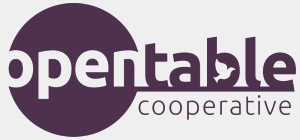Spring is blossoming around us, and our thoughts turn toward the excitement of the summer. We want to let you know our plans for the months ahead and invite you to join us.
Open Table Cooperative will be at the Church of the Brethren Annual Conference in Greensboro, North Carolina, June 29-July 3, 2016. While our work extends beyond this yearly event, we feel that our voice for bold, visionary, inclusive love is needed especially at Conference, as decisions are made that will shape the future for the congregations and individuals who call themselves Brethren. If you will be at Conference, we hope to see you!
- Mix and Mingle with us at our Wednesday night reception, over appetizers and conversation with your friends in the progressive movement. This opening night event is sponsored by your generous donations and no tickets are required to attend.
- Visit us at the booth we are sponsoring jointly with our partners in Brethren-Mennonite Council (BMC) and Womaen’s Caucus – a welcoming space within the conference venue. Or Volunteer to help staff the booth.
- Attend our Insight Session Friday evening, when Elizabeth Ullery Swenson, Kimberly Koczan Flory, Sarandon Smith, Dylan Dell-Haro, and other emerging leaders discuss building faithful community in the 21st century.
- Connect with our social media platform to keep the whole progressive movement up-to-the-minute on actions and events happening during Conference. Get a jump-start and connect with us now via Facebook at www.facebook.com/OpenTableCoop
While getting our volunteer board members to Annual Conference each year is expensive, but we feel the investment is worthwhile. We represent many voices beyond those currently at the table. And by hosting and running our social media platform, we will be connecting the voices of progressives at this Conference table. Please help us bring the Open Table voices to North Carolina this year, through a tax-deductible donation. Your donation can be made by credit card at our website, www.OpenTableCoop.org.
If you will not be attending Annual Conference this year, but want to be present in spirit, please consider sponsoring a table or half-table at our Mix-n-Mingle in Greensboro. For $250 (or $125 as a co-sponsor), your donation will help feed this movement – in body and soul. Your name will appear on a card on a table, saying “ Supports an Open Table for All.” Thank you for helping Open Table bring more voices to the table!
There is indeed work to be done. Our hearts have been broken these past months as Brethren pastors have had their credentials threatened and challenged because they performed weddings for their loving and committed same-gender congregants. Our Open Table staffer, Elizabeth Ullery Swenson, joined pastors of churches in the Supportive Communities Network this past week as they met in York Center, Illinois, to discuss ways to advance the spirit of inclusive love in the Church this summer and beyond. From these and many other conversations with progressive partners, Open Table is helping strategize action to keep moving the church toward greater inclusion. It is hard work to keep engaging in the conversations and collaborations that will produce change, but we believe that Jesus’ table that feeds each of us is not ours alone and is worth working to share.
We hope to see you this summer in person, at Annual Conference or along the way. Your support to Open Table – through your donations, your time, and your prayers – is what makes us know this work is worth it. Thank you!
Blessings,
The Open Table Cooperative Board

